












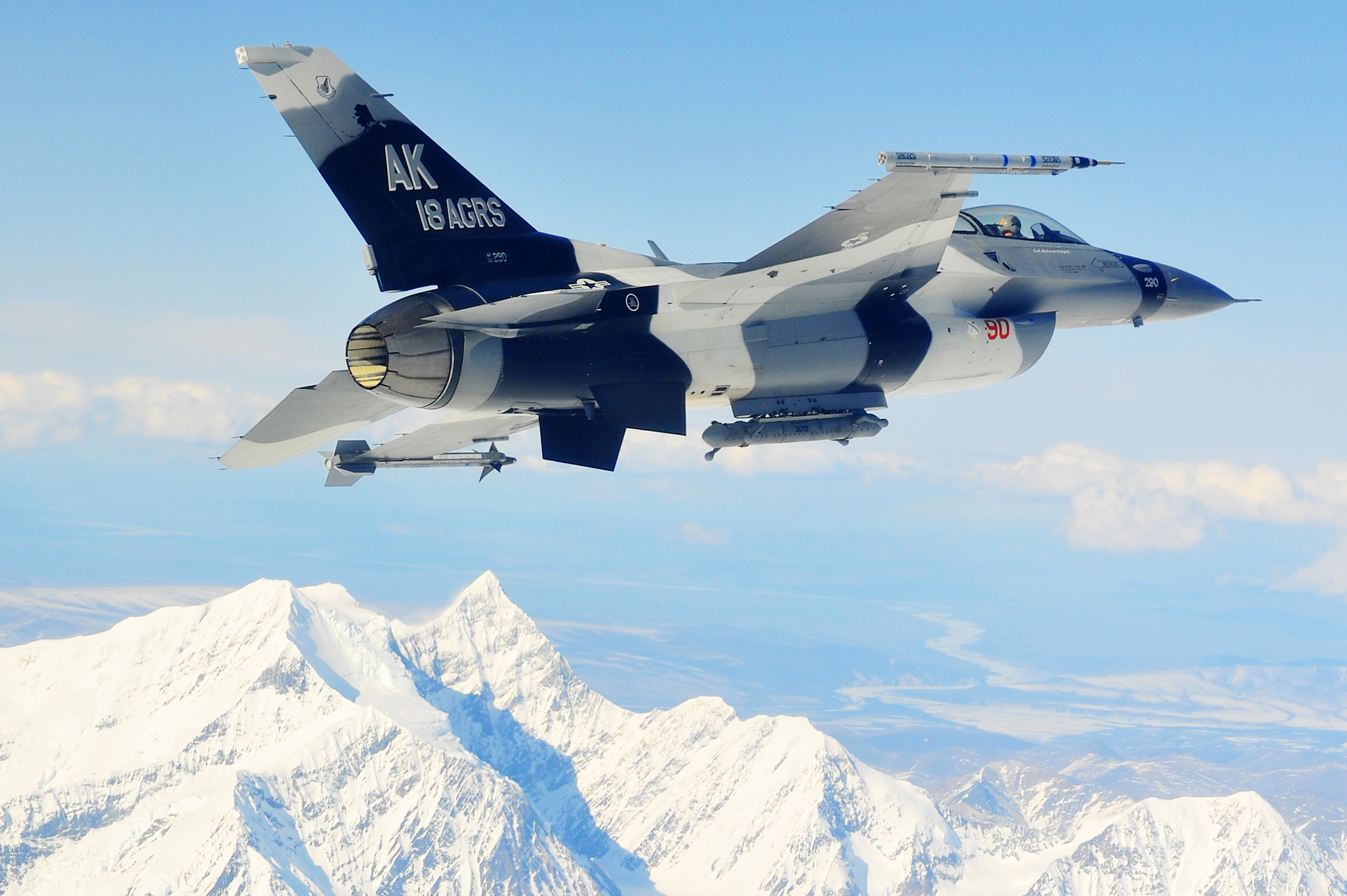


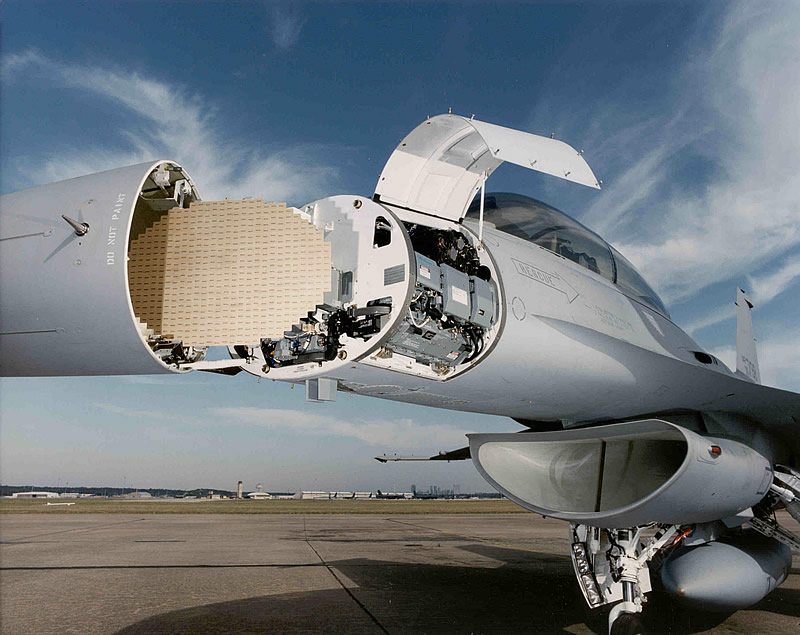
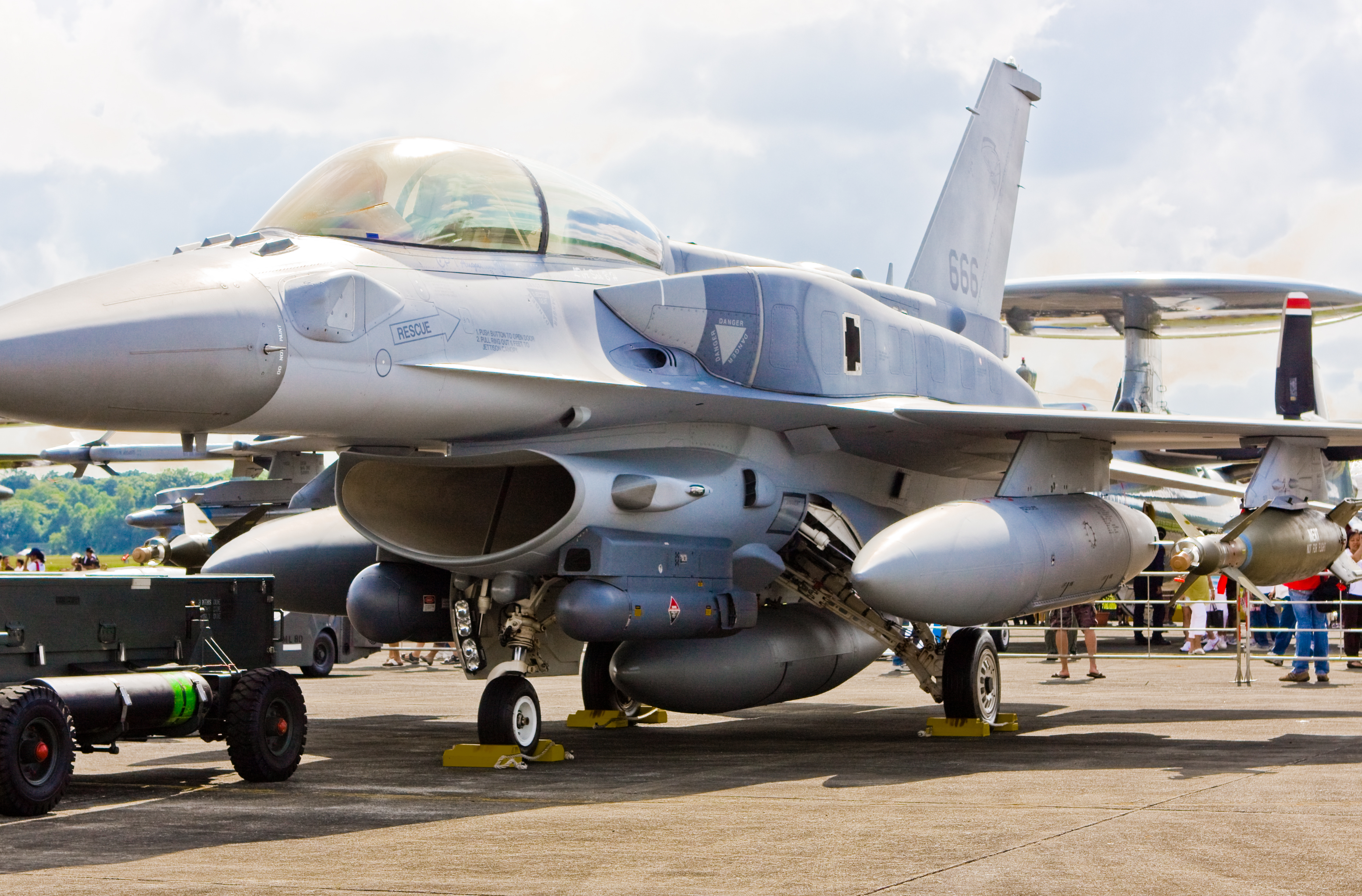
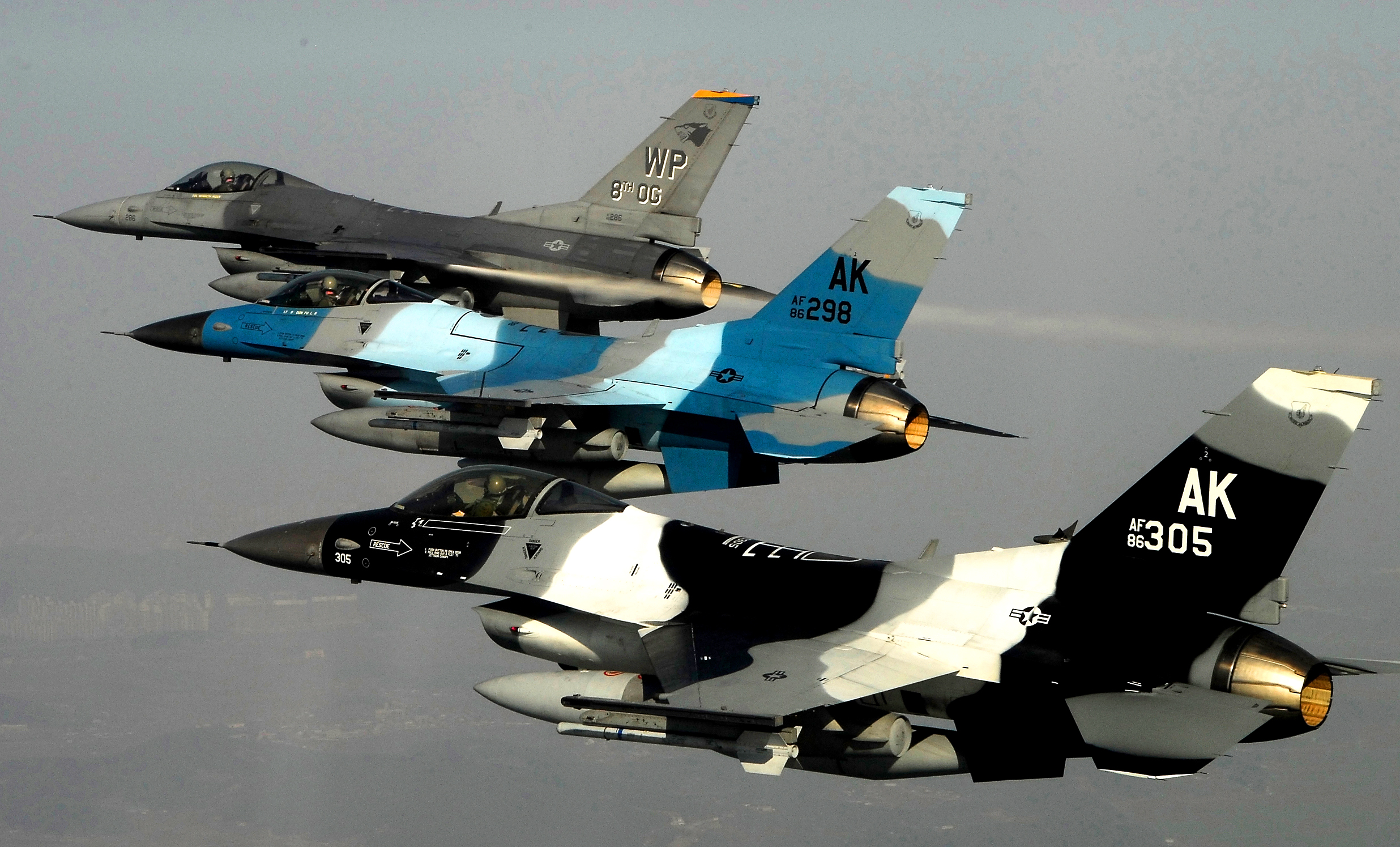
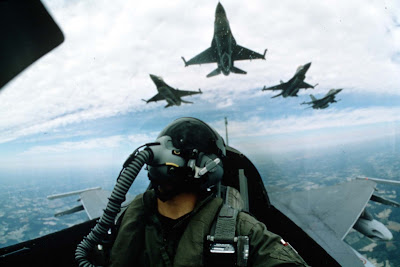

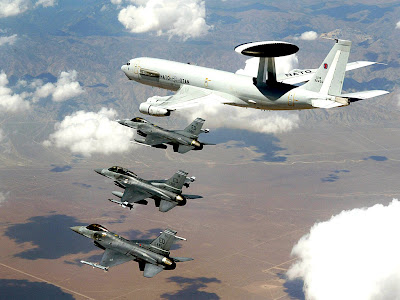

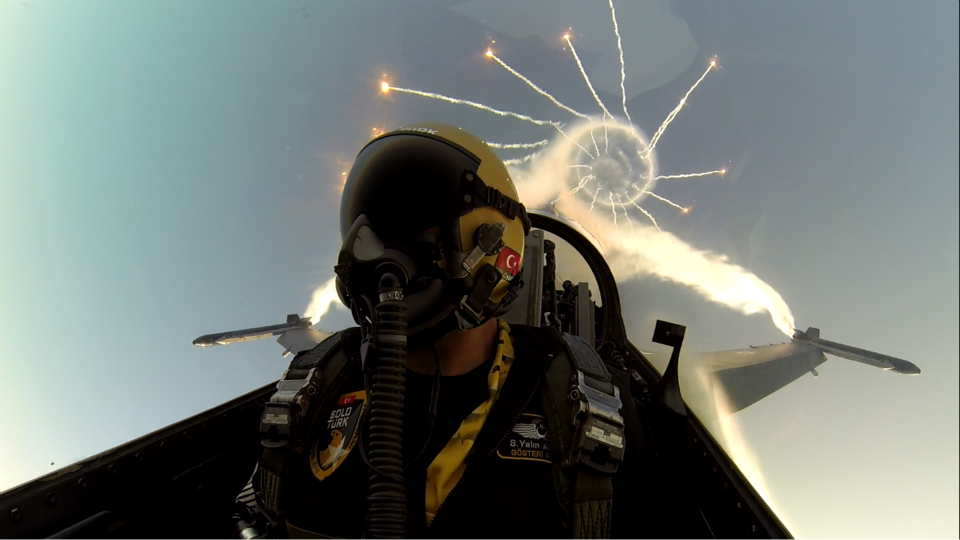
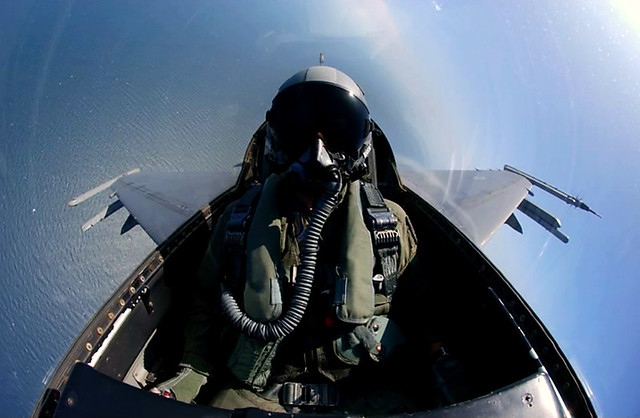

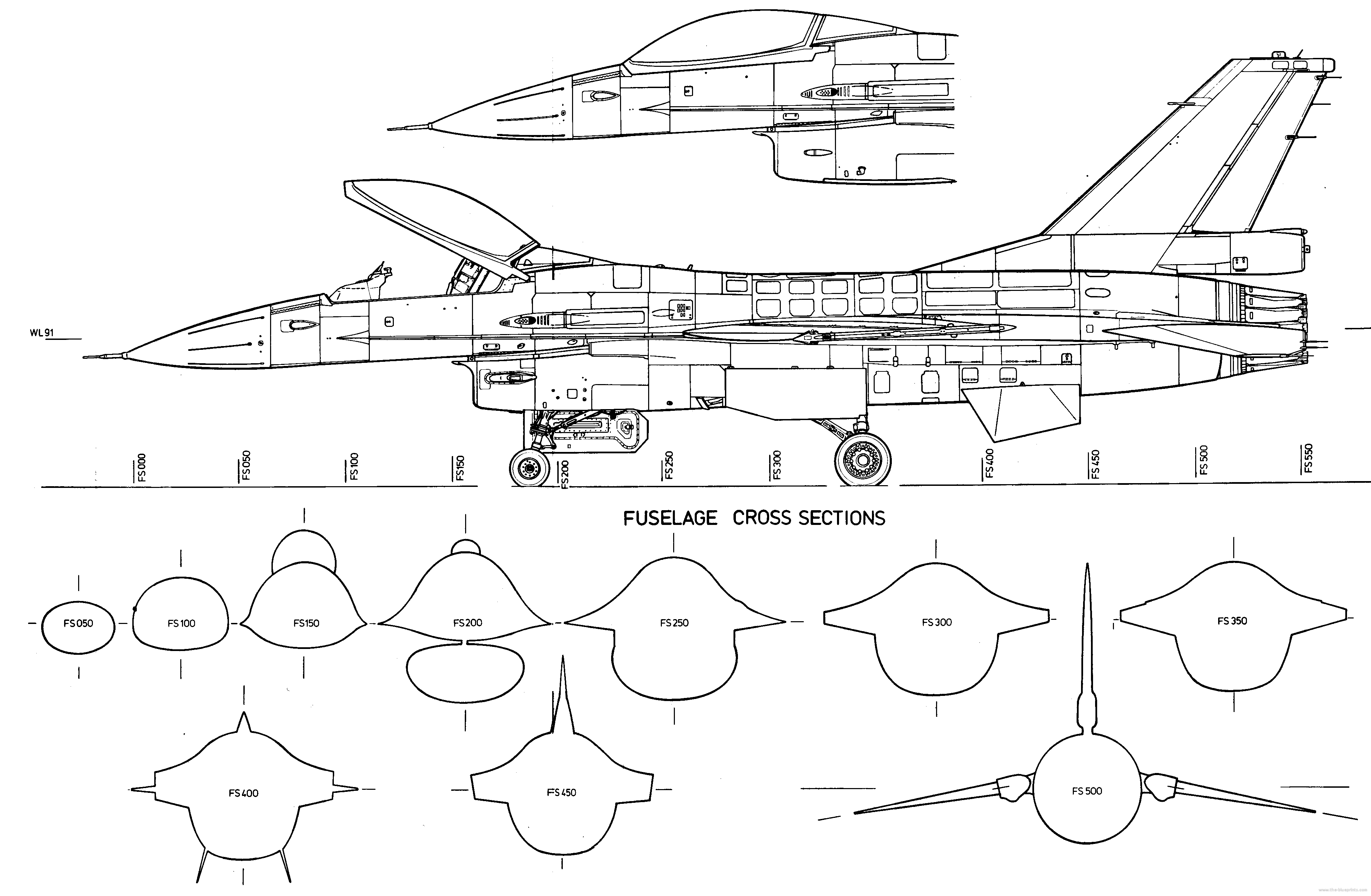
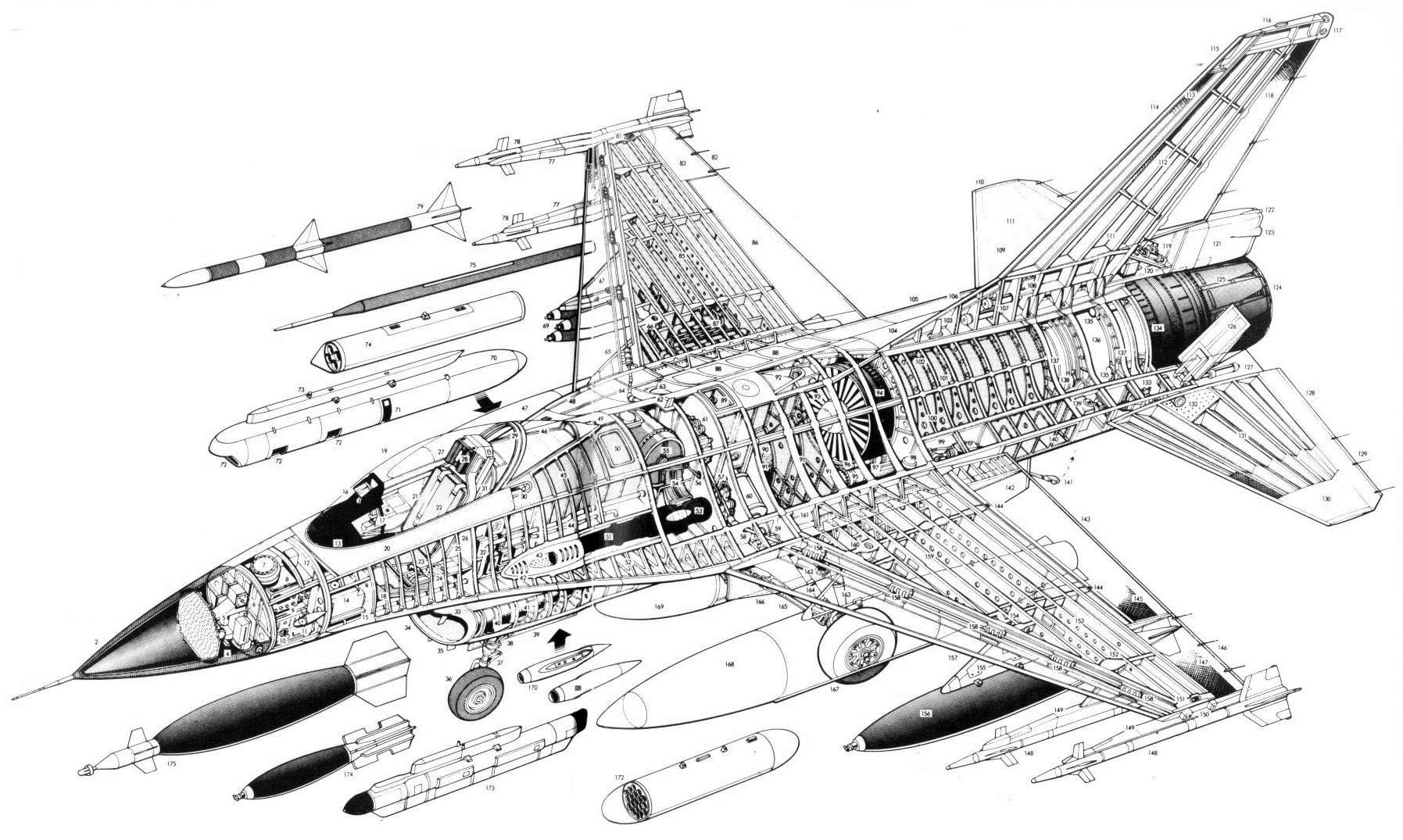
Not Your Father's F-16: Take A Tour Of The F-16IN Super Viper Cockpit
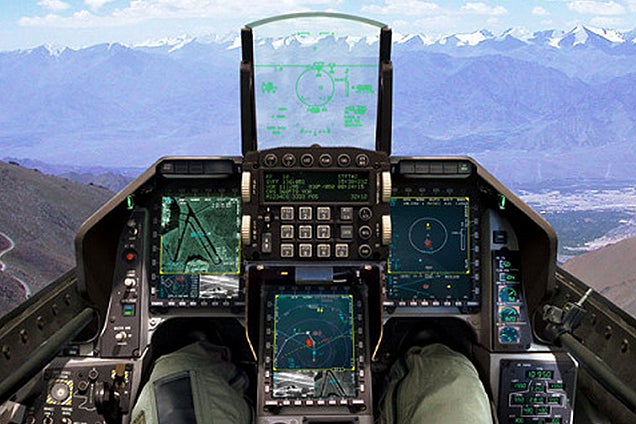
The
video below takes you on a virtual mission in the F-16IN 'Super Viper'
cockpit, showing how some of the jet's amazing avionics and automation
work. The Viper has evolved from a basic light-weight fighter into a
medium-weight strike-fighter over the last four decades and in the
F-16IN configuration it would have been one smart and deadly snake.
This video was shot during Lockheed's bid for India's Medium Multi-Role Combat Aircraft competition.
The F-16IN Super Viper variant evolved from both the F-16C/D Block 52+
and the F-16E/F Block 60 Desert Falcon. Included with this configuration
were conformal fuel tanks, a 32,500lb class turbofan engine, an evolved
cockpit with large flat panel displays, AESA radar (presumably the
APG-80 at the time) capable of simultaneous air-to-air and air-to-ground
operations, a new mission computer, digital radar warning receiver and
electronic warfare suite, an advanced datalink, digital terrain
avoidance system, along with other smaller modifications. An extendable
midair refueling probe was also going to be designed into the jet's
conformal fuel tank so that Indian Il-78 'Midas' tankers could refuel it.
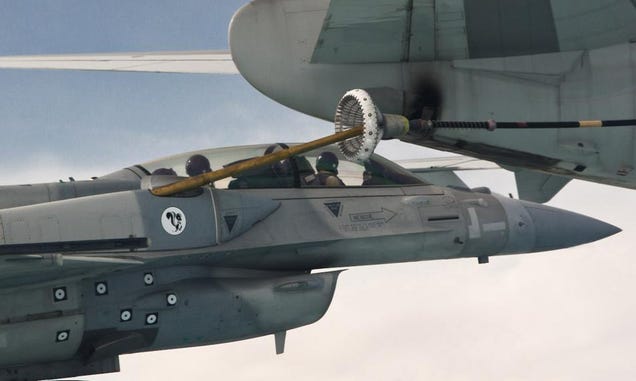
Here is a general overview of the F-16's highly efficient cockpit for further reference:
In the end,
the Indian Super Viper's single engine design, very mature nature of
the F-16s development, lack of speed and super-agility saw it lose to
the French-built Dassault Rafale.
Although
Dassault won the MMRCA competition three years ago, the MMRCA saga is
still not over and not one Rafale has been officially ordered. Almost
never-ending haggling over the terms of the contract has hobbled the
whole affair and although there appears to be some progress finally, some
in the defense world think the MMRCA will never be fulfilled. Instead
India will punt the whole program after learning a lot about many
nations' top-of-the-line fighters and opt to buy a stealthier aircraft
in large numbers, such as the Russian-Indian PAK-FA or even the F-35 Lightning.

As far as the now defunct F-16IN Super Viper goes, many of the improvements and subsystems featured in it have been adapted to the F-16V program,
which is seen as a accompaniment to the F-35, not a competitor with it.
The F-16V can be ordered as whole new aircraft or it can be ordered as
an upgrade kit, with different elements omitted or included based on the
user's needs and budget. You can compare the F-35's cockpit automation
with that of the F-16 Super Viper here

The
F-16V is fairly analogous to what Taiwan's F-16A/B force is being
upgraded to. It was also going to be the basis for an upgrade program
that would have included a large portion of America's existing F-16C/D
force, known as the Combat Avionics Programmed Extension Suite (CAPES)
which would have also operated alongside a structural upgrade as well.
This US
upgrade program, which many saw as critical for America's near term
air-warfare capabilities, was cut in what seemed like a disastrous move
to protect F-35 funding during sequestration. Still, as the F-35 continues to have teething problems,
the F-16V/CAPES Viper could end up flying with a US flag on its tail.
For the foreseeable future, the most advanced F-16s in the world will
continue to be the F-16E/F Block 60, flown by the United Arab Emirates
Air Force.
Tyler
Rogoway is a defense journalist and photographer who maintains the
website Foxtrot Alpha for Jalopnik.com You can reach Tyler with story
ideas or direct comments regarding this or any other defense topic via
the email address Tyler@Jalopnik.com

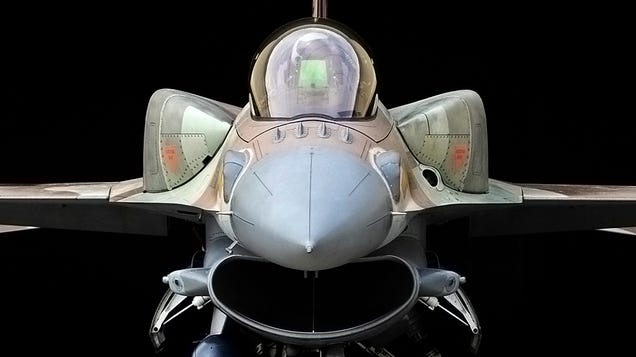
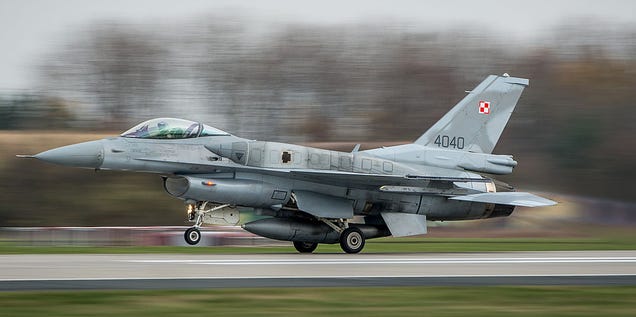
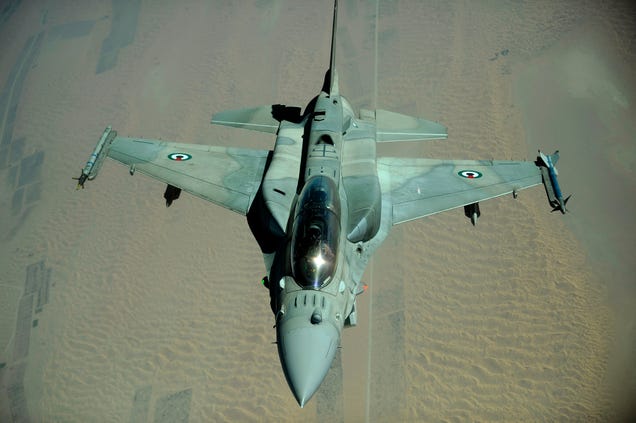

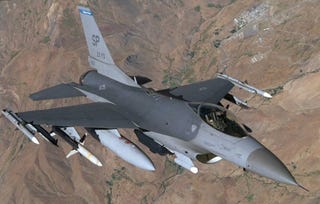
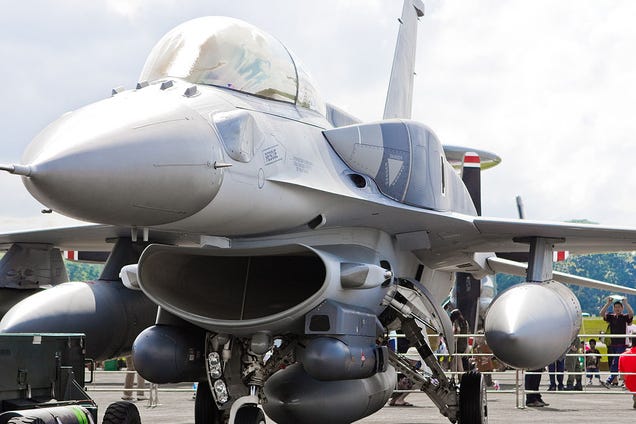
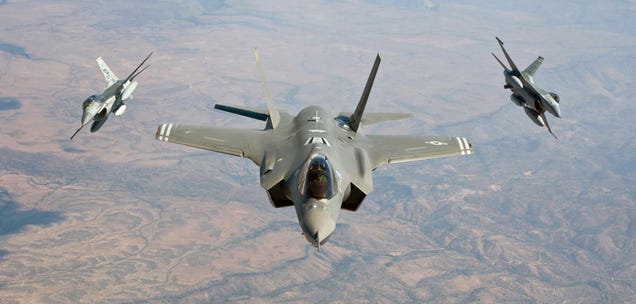
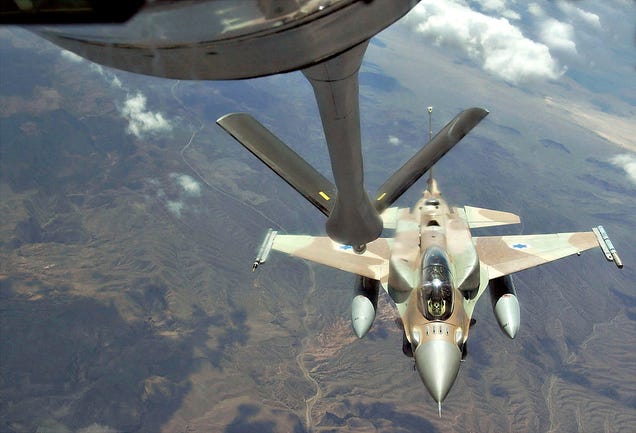
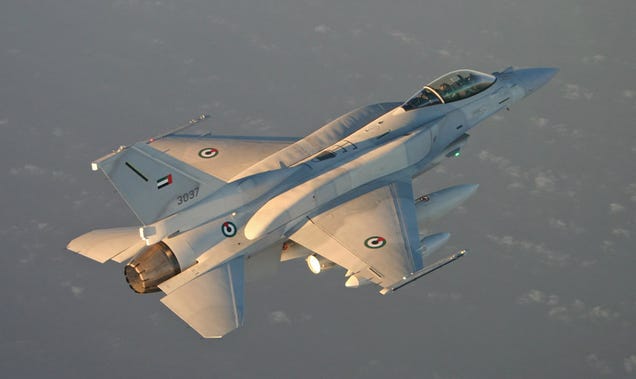
Why Don't The Newest US Air Force F-16s Use These High-Tech Fuel Tanks?

Fuel
is the ever-present specter that looms over every pilot. It’s great
when you have enough of it, and terrifying when you don’t. This is
especially true for notoriously fuel hungry tactical fighters. Conformal
Fuel Tanks (CFTs) have become an increasingly popular way to add range
to existing fighter designs, such as the F-16, without making a large
impact on the jet’s speed and agility. Many overseas operators utilize
CFTs on block 50/52 and later Vipers, but why don’t America’s late model
F-16s have a similar luxury?
Conformal Fuel Tanks are not just the domain of late model F-16s, the F-15 has long benefitted from its own CFTs,
and CFTs are in the works for the Gripen, Super Hornet, Rafale, Ching
Kuo and Eurofighter. Advanced versions of the MiG-29 have also been
fitted with a dorsal conformal fuel tank and China’s J-10 has a CFT
option in development.
The F-16’s
CFTs weigh just 900 pounds per set and can carry 450 gallons, about
3,050 pounds of jet fuel. Considering that an F-16 holds about 7,000
pounds of internal fuel, just the CFTs alone offer a 43.5 percent fuel
increase with little additional drag. Also, they don’t take up precious
stores stations under the jet’s wings or belly like traditional drop
tanks.

Pilots have been fairly explicit about how little the F-16’s CFT’s impact the F-16’s notoriously spirited performance.
Maj. Timothy McDonald, U.S. Air Force project pilot for F-16 CFT
testing at Eglin AFB described the bolt-on addition like this:
“The CFTs have very little adverse effect on the F-16’s renowned performance. A set of CFTs carries 50 percent more fuel than the centerline external fuel tank, but has only 12 percent of the drag. The aircraft retains its full 9-g capability and flight envelope with the CFTs installed. The drag impact is very small, less than one percent in combat configuration at cruise conditions.”
Stephen Barter, Lockheed’s CFT project pilot at the time of their developed also stated:
“The flying qualities of the F-16 with CFTs are essentially unchanged when compared to a non-CFT equipped airplane. For most combat flight conditions, it’s as if the CFTs are not even there. The surest way for me to tell if CFTs are installed is to look over my shoulder.”
F-16 CFTs
are designed for the jet’s full flight envelope, up to 9 g’s, maximum
angle of attack, sideslip and maximum roll rate and they have almost no
impact on maneuverability or speed below mach one, where fighters spend
the vast majority of their time. Even above mach one, they have less
performance impact and carry more fuel then a centerline drop tank.
While
Israel, Turkey, Poland, Greece, Morocco, Pakistan, Oman, Singapore and
the UAE all actively use CFTs on their F-16 fleets, the U.S. has
bypassed the option all together.

Seeing as
USAF F-16s never fly in combat without multiple external fuel tanks,
which greatly hampers the jet’s performance, aren’t CFT’s a no-brainer?
It would seem so, but the USAF uses some seemingly backward logic when
it comes to not procuring them for their Block 50/52 F-16 fleet, which
is the top-of-the-line, youngest F-16 sub-fleet in the USAF’s inventory.
From what I
have gathered over the years on the topic via talking to pilots
directly and seeing mentions of the decision in publications from time
to time, the USAF justifies not procuring CFTs because it already has so
many tanker aircraft. Additionally, in a major air battle they don’t
need the extra weapons stations freed up by the inclusion of CFTs as a
great advantage because they can simply assign more F-16s to target set.
For longer-range strike missions they can use the F-15E or even a
bomber.
These
justifications, and the fact that although the CFTs don’t inhibit daily
line maintenance and inspections when fitted to the aircraft they do
take a couple hours to remove for heavy duty servicing and phase
inspections, seems to be entire reasoning behind not equipping American
late model Vipers with CFTs.

Now let’s
take a closer look at this rationale. It is true that the U.S. has a
dizzying amount of tanker aircraft, about 450 in total, with 59 being
KC-10 Extenders and the rest being KC-135R Stratotankers. These aircraft
can also be used for cargo missions but mainly they provide refueling
for thirsty U.S. and allied military aircraft. Meanwhile, the F-16 still
represents the backbone of the USAF’s tactical air combat capability,
with over 900 units still in service even after many squadrons have been
shuttered due to budgetary cuts.
Over 250 of
these aircraft are Block 50/52 F-16CJs that were delivered optimized
for CFTs. In other words, around 30 percent of the USAF most advanced
and youngest F-16s could easily be fitted with CFTs, many of which have
the challenging “Wild Weasel” Suppression of Enemy Air
Defense/Destruction of Enemy Air Defenses (SEAD/DEAD) mission. This
demanding mission is a critical support capability that is needed to
ensure the safety of both short-ranged and long-ranged aircraft against
an enemy with even a rudimentary air defense system.

The F-16,
with its limited range and “work in progress” Harm Targeting System
(HTS), has never been ideally suited for this mission, only really coming into its own in it after key avionics and weapons upgrades
over the last decade or so. The addition of another 40 percent or so of
internal fuel would help make the jet the best Wild Weasel it could
possibly be, and give it the legs it needs to work anti-aircraft systems
over while strike and counter-air aircraft accomplish their missions in
enemy airspace.
Adding
close to 50 percent internal fuel to 25 percent of the USAF’s existing
F-16 fleet offers a slew of benefits, both tactically and strategically.
First off, greatly enhanced loiter time and range. This will allow
these F-16s to not be as closely tethered to aerial tankers as they are
today, having to depart roughly every hour to refuel while over the
combat area, which greatly complicates planning and can leave a hole
over a key area of the battlefield. This is especially when executing
critical close air support (CAS) and Wild Weasel missions.
On medium
and short range missions, CFTs mean more maneuverability, less drag
penalty and more weapons available per aircraft when compared to flying
an F-16 with cumbersome under-wing tanks. On long-range missions, where
underwing drop tanks are paired with CFTs, it means enhanced range and
on station time.

As for the
idea that the USAF’s massive tanker force makes CFTs less relevant, this
seems like a very near sighted look at the enhanced capabilities CFTs
offer, and it is a somewhat archaic look at the current realities of air
combat.
America’s
tanker fleet will erode in numbers over time. The KC-135s, many of which
are over 50 years old, cannot fly forever, and finding funding for
replacing them on a one-to-one basis with the KC-46 will
be all but impossible. Even the heavy hauling KC-10 Extenders have been
under the budget axe as of late, simply due to their cost of operation.
Keep in
mind that this comes as the USAF looks to procure over 1700 F-35As, each
carrying over two and a half times the internal fuel as their F-16
counterparts. This would not be an issue if the new stealthy jets
featured over double the range or combat radius, but they don’t. As
such, they will be highly dependent on tanker gas to accomplish their
mission just as their F-16 predecessors, only they are much more
thirsty. This will put greater pressure on a shrinking tanker fleet
during future conflicts.

Then you
have the Pentagon’s supposed “pivot towards the Pacific,” where long
distances and the realities of limited logistics and austere basing and
support infrastructure are the greatest challenges to overcome. Allowing
America’s Block 50/52 F-16C/Ds to operate more independently of
tankers, over greater ranges, is a logical move if this strategy is
going to be taken seriously.
Then there
is the tanker vulnerability issue, as they are large targets incapable
of defending themselves, and tasked with operating within a few hundred
miles of their short-legged fighter dependents. During a war against an
enemy with anti-access and area-denial capabilities, this could mean
long ‘tanker bridges’ shuffling fighters from far away bases to the
front lines. It also means that the tankers themselves will be
far-forward deployed. As such, they will be vulnerable to enemy attack,
especially during swarming enemy operations, or those where advanced
low-observable enemy aircraft are being used. Thus, the farther these
tankers can be pushed back by increasing our combat aircraft’s organic
range the safer they will be during such a conflict conflict.
Also keep
in mind that over the vast reaches of the Pacific, during even a limited
near peer-state conflict, if the enemy kills the tanker, they may also
have killed all the fighters dependent on that tanker as they would have
to divert to bases vulnerable to enemy attack or run out of fuel and
ditch in the ocean.

Finally,
you have cost. Tanker gas costs anywhere from $25-$35 per gallon (some
claim it is closer to $50) when you factor in the costs associated with
aerial refueling. This is in comparison to about $5 to $6 when an
aircraft is fueled on the ground. During sustained low-intensity warfare
operations or during training, relying more on ground-based fuel than
on tankers is a much more economical way to go about the fighter
business. It will also offer more time per sortie during training when
aerial refueling assets are not used. This means less aircraft “turns”
and much greater efficiency when getting pilots their required training
hours. Less sorties, but longer ones, is also easier on the hardware.
The best
part about the CFTs is that they are removable. For certain operations,
if they are deemed unnecessary, the aircraft can be left stripped of
them, and for other missions they can be fitted. For instance, over
Afghanistan, where persistence during CAS missions was key and there was
no air-to-air or advanced surface-to-air threat, hauling some 40
percent more gas while being able to carry more weapons seems like a
pretty logical advantage. Yet even during combat operations, where there
is a robust surface-to-air and air-to-air thrust, any slight hinderance
the CFTs cause to agility, which apparently is almost nothing, is
overcome by being able to stay in the fight longer at higher thrust
settings.
Also, we live in time of high-off bore-sight air-to-air missiles
and towed decoys, where raw agility is becoming less and less of
advantage in combat. Instead, range, persistence and the ability to get
the maximum out of the aircraft’s powerplant when needed, for as long as
needed, are what’s paramount
The claim
that the USAF can just stack more F-16s to take out a set amount of
targets and fulfill a set number of patrols seems incredibly reckless.
Just because the assets are available it does not mean their use is
necessary. Why put more crews and material at risk than you absolutely
have to during a time of war? Especially considering that losing just
one F-16 will end up in putting so many more personnel at risk during a
combat search and rescue operation.
The fact of
the matter is that America’s youngest F-16s will continue to serve for
decades to come, most likely taking on many of the ‘bread and butter’
roles that using a $100M+ stealth fighter makes absolutely no sense for.
With all
this in mind isn’t it totally reasonable to ease up a bit on America’s
fighter force tanker gas addiction and give F-16C/D Block 50/52 crews
more persistence and range via the addition of CFTs? Especially
considering the capability is proven, bolt on in nature, has little
adverse consequences when it comes to agility and is already available
off the shelf?
Logic would say yes, but the USAF somehow says no.

Contact the author at Tyler@jalopnik.com.
Photos:
Turkish F-16 wikicommons/SAC Helen Farrer RAF Mobile News Team,
Singapore F-16 Wikicommpns/Luhai Wong, Polish F-16 Wikicommons/SFJZ, Top
shot IAF/IDF, Bottom shot via Lockheed Martin, all other photos via
USAF.
General Dynamics F-16 Fighting Falcon
From Wikipedia, the free encyclopedia
"F-16 Fighting Falcon" redirects here. For the video game, see Falcon (video game series).
| F-16 Fighting Falcon | |
|---|---|
 |
|
| A USAF F-16C over Iraq in 2008 | |
| Role | Multirole fighter aircraft |
| National origin | United States |
| Manufacturer | General Dynamics Lockheed Martin |
| First flight | 20 January 1974 |
| Introduction | 17 August 1978 |
| Status | In service |
| Primary users | United States Air Force 25 other users (see operators page) |
| Produced | 1973–present |
| Number built | 4,540+[1] |
| Unit cost | |
| Variants | General Dynamics F-16 VISTA |
| Developed into | Vought Model 1600 General Dynamics F-16XL Mitsubishi F-2 |
The Fighting Falcon has key features including a frameless bubble canopy for better visibility, side-mounted control stick to ease control while maneuvering, a seat reclined 30 degrees to reduce the effect of g-forces on the pilot, and the first use of a relaxed static stability/fly-by-wire flight control system helps to make it a nimble aircraft. The F-16 has an internal M61 Vulcan cannon and 11 locations for mounting weapons and other mission equipment. The F-16's official name is "Fighting Falcon", but "Viper" is commonly used by its pilots, due to a perceived resemblance to a viper snake as well as the Battlestar Galactica Colonial Viper starfighter.[6][7]
In addition to active duty U.S. Air Force, Air Force Reserve Command, and Air National Guard units, the aircraft is also used by the USAF aerial demonstration team, the U.S. Air Force Thunderbirds, and as an adversary/aggressor aircraft by the United States Navy. The F-16 has also been procured to serve in the air forces of 25 other nations.[8]
Development
Lightweight Fighter program
Main article: Lightweight Fighter program
Experience in the Vietnam War revealed the need for air superiority fighters and better air-to-air training for fighter pilots.[9] Based on his experiences in the Korean War and as a fighter tactics instructor in the early 1960s Colonel John Boyd with mathematician Thomas Christie developed the Energy-Maneuverability theory
to model a fighter aircraft's performance in combat. Boyd's work called
for a small, lightweight aircraft that could maneuver with the minimum
possible energy loss, and which also incorporated an increased thrust-to-weight ratio.[10][11] In the late 1960s, Boyd gathered a group of like-minded innovators that became known as the Fighter Mafia and in 1969 they secured Department of Defense funding for General Dynamics and Northrop to study design concepts based on the theory.[12][13]Air Force F-X proponents remained hostile to the concept because they perceived it as a threat to the F-15 program. However, the Air Force's leadership understood that its budget would not allow it to purchase enough F-15 aircraft to satisfy all of its missions.[14] The Advanced Day Fighter concept, renamed F-XX, gained civilian political support under the reform-minded Deputy Secretary of Defense David Packard, who favored the idea of competitive prototyping. As a result in May 1971, the Air Force Prototype Study Group was established, with Boyd a key member, and two of its six proposals would be funded, one being the Lightweight Fighter (LWF). The Request for Proposals issued on 6 January 1972 called for a 20,000-pound (9,100 kg) class air-to-air day fighter with a good turn rate, acceleration and range, and optimized for combat at speeds of Mach 0.6–1.6 and altitudes of 30,000–40,000 feet (9,100–12,000 m). This was the region where USAF studies predicted most future air combat would occur. The anticipated average flyaway cost of a production version was $3 million. This production plan, though, was only notional as the USAF had no firm plans to procure the winner.[15][16]
Finalists selected and flyoff

The YF-16 was developed by a team of General Dynamics engineers led by Robert H. Widmer.[19] The first YF-16 was rolled out on 13 December 1973, and its 90-minute maiden flight was made at the Air Force Flight Test Center (AFFTC) at Edwards AFB, California, on 2 February 1974. Its actual first flight occurred accidentally during a high-speed taxi test on 20 January 1974. While gathering speed, a roll-control oscillation caused a fin of the port-side wingtip-mounted missile and then the starboard stabilator to scrape the ground, and the aircraft then began to veer off the runway. The test pilot, Phil Oestricher, decided to lift off to avoid a potential crash, safely landing six minutes later. The slight damage was quickly repaired and the official first flight occurred on time. The YF-16's first supersonic flight was accomplished on 5 February 1974, and the second YF-16 prototype first flew on 9 May 1974. This was followed by the first flights of Northrop's YF-17 prototypes on 9 June and 21 August 1974, respectively. During the flyoff, the YF-16s completed 330 sorties for a total of 417 flight hours;[20] the YF-17s flew 288 sorties, covering 345 hours.[21]
Air Combat Fighter competition
Increased interest would turn the LWF into a serious acquisition program. North Atlantic Treaty Organization (NATO) allies Belgium, Denmark, the Netherlands, and Norway were seeking to replace their F-104G fighter-bombers.[22] In early 1974, they reached an agreement with the U.S. that if the USAF ordered the LWF winner, they would consider ordering it as well. The USAF also needed to replace its F-105 and F-4 fighter-bombers. The U.S. Congress sought greater commonality in fighter procurements by the Air Force and Navy, and in August 1974 redirected Navy funds to a new Navy Air Combat Fighter (NACF) program that would be a navalized fighter-bomber variant of the LWF. The four NATO allies had formed the "Multinational Fighter Program Group" (MFPG) and pressed for a U.S. decision by December 1974; thus the USAF accelerated testing.[23][24][25]On 13 January 1975, Secretary of the Air Force John L. McLucas announced the YF-16 as the winner of the ACF competition.[28] The chief reasons given by the Secretary were the YF-16's lower operating costs, greater range, and maneuver performance that was "significantly better" than that of the YF-17, especially at supersonic speeds. Another advantage of the YF-16 – unlike the YF-17 – was its use of the Pratt & Whitney F100 turbofan engine, the same powerplant used by the F-15; such commonality would lower the cost of engines for both programs.[29] Secretary McLucas announced that the USAF planned to order at least 650, possibly up to 1,400 production F-16s. In the Navy Air Combat Fighter (NACF) competition, on 2 May 1975 the Navy selected the YF-17 as the basis for what would become the McDonnell Douglas F/A-18 Hornet.[30][31]
Into production
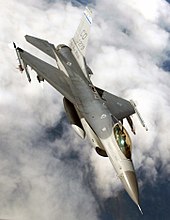
The FSD F-16s were manufactured at General Dynamics' Fort Worth, Texas plant in late 1975; the first F-16A rolled out on 20 October 1976 and first flew on 8 December. The initial two-seat model achieved its first flight on 8 August 1977. The initial production-standard F-16A flew for the first time on 7 August 1978 and its delivery was accepted by the USAF on 6 January 1979. The F-16 was given its formal nickname of "Fighting Falcon" on 21 July 1980, entering USAF operational service with the 34th Tactical Fighter Squadron, 388th Tactical Fighter Wing at Hill AFB on 1 October 1980.[35]
On 7 June 1975, the four European partners, now known as the European Participation Group, signed up for 348 aircraft at the Paris Air Show. This was split among the European Participation Air Forces (EPAF) as 116 for Belgium, 58 for Denmark, 102 for the Netherlands, and 72 for Norway. Two European production lines, one in the Netherlands at Fokker's Schiphol-Oost facility and the other at SABCA's Gosselies plant in Belgium, would produce 184 and 164 units respectively. Norway's Kongsberg Vaapenfabrikk and Denmark's Terma A/S also manufactured parts and subassemblies for EPAF aircraft. European co-production was officially launched on 1 July 1977 at the Fokker factory. Beginning in November 1977, Fokker-produced components were sent to Fort Worth for fuselage assembly, then shipped back to Europe for final assembly of EPAF aircraft at the Belgian plant on 15 February 1978; deliveries to the Belgian Air Force began in January 1979. The first Royal Netherlands Air Force aircraft was delivered in June 1979. In 1980, the first aircraft were delivered to the Royal Norwegian Air Force by SABCA and to the Royal Danish Air Force by Fokker.[36][37]
During the late 1980s and 1990s, Turkish Aerospace Industries (TAI) produced 232 Block 30/40/50 F-16s on a production line in Ankara under license for the Turkish Air Force. TAI also produced 30 Block 50 from 2010, and built 46 Block 40s for Egypt in the mid-1990s. Korean Aerospace Industries opened a domestic production line for the KF-16 program, producing 140 Block 52s from the mid-1990s to mid-2000s (decade). If India had selected the F-16IN for its Medium Multi-Role Combat Aircraft procurement, a sixth F-16 production line would be built in India.[38] In May 2013, Lockheed Martin stated there were currently enough orders to keep producing the F-16 until 2017.[39]
Improvements and upgrades
One change made during production was augmented pitch control to avoid deep stall conditions at high angles of attack. The stall issue had been raised during development, but had originally been discounted. Model tests of the YF-16 conducted by the Langley Research Center revealed a potential problem, but no other laboratory was able to duplicate it. YF-16 flight tests were not sufficient to expose the issue; later flight testing on the FSD aircraft demonstrated there was a real concern. In response, the areas of the horizontal stabilizer were increased 25% on the Block 15 aircraft in 1981 and later retrofitted to earlier aircraft. In addition, a manual override switch to disable the horizontal stabilizer flight limiter was placed more prominently on the control console, allowing the pilot to regain control of the horizontal stabilizers (which the flight limiters otherwise lock in place) and recover. Besides a significant reduction in the risk of deep stalls, the larger horizontal tail also improved stability and permitted faster takeoff rotation.[40][41]In the 1980s, the Multinational Staged Improvement Program (MSIP) was conducted to evolve new capabilities for the F-16, mitigate risks during technology development, and ensure the aircraft's worth. The program upgraded the F-16 in three stages. The MSIP process permitted the introduction of new capabilities quicker, at lower costs and with reduced risks, compared to traditional independent programs to upgrade and modernize aircraft.[42] In 2012, the USAF had allocated $2.8 billion to upgrade 350 F-16s while waiting for the F-35 to enter service.[43] One key upgrade has been an auto-GCAS system to reduce instances of controlled flight into terrain.[44] Onboard power and cooling capacities have limited the scope of upgrades, many of which involve the addition of more power-hungry avionics.[45]
Lockheed has won many contracts with foreign operators to upgrade their F-16s; BAE Systems also offers their own series of F-16 upgrades and has received orders from South Korea, Oman, Turkey, and the US Air National Guard.[46][47][48] In 2012, the USAF assigned the total upgrade contract to Lockheed Martin, including the radar.[49] Upgrades include Raytheon’s Center Display Unit, which replaces several analog flight instruments with a single digital display.[50] However budget cuts have cast doubt on the USAF's ability to complete the Combat Avionics Programmed Extension Suite (CAPES), which is part of secondary programs such as the Taiwan F-16 upgrade.[51] ACC's General Hostage stated that if he only had money for SLEP or CAPES, he would apply it to SLEP to keep the aircraft flying.[52] Lockheed Martin responded to talk of CAPES cancellation with a fixed-price upgrade package for foreign users,[53] and CAPES was not included in the Pentagon's 2015 budget request.[54] The USAF has said that the upgrade package will still be offered to Taiwan, and Lockheed has said that some of the common elements with the F-35 will keep the unit costs of the radars down.[55]
Design
Overview
The F-16 was designed to be relatively inexpensive to build and simpler to maintain than earlier-generation fighters. The airframe is built with about 80% aviation-grade aluminum alloys, 8% steel, 3% composites, and 1.5% titanium. The leading-edge flaps, tailerons, and ventral fins make use of bonded aluminum honeycomb structures and graphite epoxy laminate coatings. The number of lubrication points, fuel line connections, and replaceable modules is significantly lower than predecessors; 80% of access panels can be accessed without stands.[38] The air intake was designed: "far enough forward to allow a gradual bend in the air duct up to the engine face to minimize flow losses and far enough aft so it wouldn't weigh too much or be too draggy or destabilizing."[56]
Although the LWF program called for a structural life of 4,000 flight hours, capable of achieving 7.33 g with 80% internal fuel; GD's engineers decided to design the F-16's airframe life for 8,000 hours and for 9-g maneuvers on full internal fuel. This proved advantageous when the aircraft's mission changed from solely air-to-air combat to multi-role operations. Changes in operational use and additional systems have increased weight, necessitating multiple structural strengthening programs.[57]
General configuration
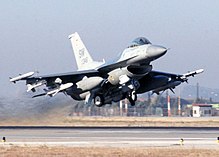
Aerodynamic studies in the 1960s demonstrated that the "vortex lift" phenomenon could be harnessed by highly swept wing configurations to reach higher angles of attack, using leading edge vortex flow off a slender lifting surface. As the F-16 was being optimized for high combat agility, GD's designers chose a slender cropped-delta wing with a leading edge sweep of 40° and a straight trailing edge. To improve maneuverability, a variable-camber wing with a NACA 64A-204 airfoil was selected; the camber is adjusted by leading-edge and trailing edge flaperons linked to a digital flight control system (FCS) regulating the flight envelope.[38][57] The F-16 has a moderate wing loading, reduced by fuselage lift.[59] The vortex lift effect is increased by leading edge extensions, known as strakes. Strakes act as additional short-span, triangular wings running from the wing root (the juncture with the fuselage) to a point further forward on the fuselage. Blended into the fuselage and along the wing root, the strake generates a high-speed vortex that remains attached to the top of the wing as the angle of attack increases, generating additional lift and allowing greater angles of attack without stalling. Strakes allow a smaller, lower-aspect-ratio wing, which increases roll rates and directional stability while decreasing weight. Deeper wingroots also increase structural strength and internal fuel volume.[57]
Early F-16s could be armed with up to six AIM-9 Sidewinder heat-seeking short-range air-to-air missiles (AAM), including rail launchers on each wingtip. Some F-16s can employ the AIM-7 Sparrow medium-range AAM; more recent versions can equip the AIM-120 AMRAAM. It can also carry other AAM; a wide variety of air-to-ground missiles, rockets or bombs; electronic countermeasures (ECM), navigation, targeting or weapons pods; and fuel tanks on 9 hardpoints – six under the wings, two on wingtips, and one under the fuselage; two other locations under the fuselage are available for sensor or radar pods.[60]
Negative stability and fly-by-wire
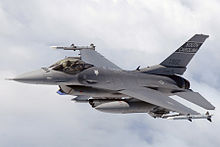
To counter the tendency to depart from controlled flight—and avoid the need for constant trim inputs by the pilot, the F-16 has a quadruplex (four-channel) fly-by-wire (FBW) flight control system (FLCS). The flight control computer (FLCC) accepts pilot input from the stick and rudder controls, and manipulates the control surfaces in such a way as to produce the desired result without inducing control loss. The FLCC conducts thousands of measurements per second on the aircraft's flight attitude to automatically counter deviations from the pilot-set flight path; leading to a common aphorism among pilots: "You don't fly an F-16; it flies you."[64]
The FLCC further incorporates limiters governing movement in the three main axes based on attitude, airspeed and angle of attack (AOA); these prevent control surfaces from inducing instability such as slips or skids, or a high AOA inducing a stall. The limiters also prevent maneuvers that would exert more than a 9 g load.[65] Flight testing has revealed that "assaulting" multiple limiters at high AOA and low speed can result in an AOA far exceeding the 25° limit, colloquially referred to as "departing"; this causes a deep stall; a near-freefall at 50° to 60° AOA, either upright or inverted. While at a very high AOA, the aircraft's attitude is stable but control surfaces are ineffective; the pitch limiter locks the stabilators at an extreme pitch-up or pitch-down attempting to recover, this can be overridden so the pilot can "rock" the nose via pitch control to recover.[66]
Unlike the YF-17, which had hydromechanical controls serving as a backup to the FBW, General Dynamics took the innovative step of eliminating mechanical linkages between the control stick and rudder pedals, and the aerodynamic control surfaces. The F-16 is entirely reliant on its electrical systems to relay flight commands, instead of traditional mechanically-linked controls, leading to the early moniker of "the electric jet". The quadruplex design permits "graceful degradation" in flight control response in that the loss of one channel renders the FLCS a "triplex" system.[67] The FLCC began as an analog system on the A/B variants, but has been supplanted by a digital computer system beginning with the F-16C/D Block 40.[68][69] The F-16's controls suffered from a sensitivity to static electricity or electrostatic discharge (ESD). Up to 70–80% of the C/D models' electronics were vulnerable to ESD.[70]
Cockpit and ergonomics
A key feature of the F-16's cockpit is the exceptional field of view. The single-piece, bird-proof polycarbonate bubble canopy provides 360° all-round visibility, with a 40° look-down angle over the side of the aircraft, and 15° down over the nose (compared to the common 12–13° of preceding aircraft); the pilot's seat is elevated for this purpose. Furthermore, the F-16's canopy lacks the forward bow frame found on many fighters, which is an obstruction to a pilot's forward vision.[38][71] The F-16's ACES II zero/zero ejection seat is reclined at an unusual tilt-back angle of 30°; most fighters have a tilted seat at 13–15°. The tilted seat can accommodate taller pilots and increases G-force tolerance; however it has been associated with reports of neck ache, possibly caused by incorrect head-rest usage.[72] Subsequent U.S. fighters have adopted more modest tilt-back angles of 20°.[38][73] Due to the seat angle and the canopy's thickness, the ejection seat lacks canopy-breakers for emergency egress; instead the entire canopy is jettisoned prior to the seat's rocket firing.[74]The pilot flies primarily by means of an armrest-mounted side-stick controller (instead of a traditional center-mounted stick) and an engine throttle; conventional rudder pedals are also employed. To enhance the pilot's degree of control of the aircraft during high-g combat maneuvers, various switches and function controls were moved to centralised "hands on throttle-and-stick (HOTAS)" controls upon both the controllers and the throttle. Hand pressure on the side-stick controller is transmitted by electrical signals via the FBW system to adjust various flight control surfaces to maneuver the F-16. Originally the side-stick controller was non-moving, but this proved uncomfortable and difficult for pilots to adjust to, sometimes resulting in a tendency to "over-rotate" during takeoffs, so the control stick was given a small amount of "play". Since introduction on the F-16, HOTAS controls have become a standard feature on modern fighters.[75]
The F-16 has a head-up display (HUD), which projects visual flight and combat information in front of the pilot without obstructing the view; being able to keep his head "out of the cockpit" improves a pilot's situational awareness.[76] Further flight and systems information are displayed on multi-function displays (MFD). The left-hand MFD is the primary flight display (PFD), typically showing radar and moving-maps; the right-hand MFD is the system display (SD), presenting information about the engine, landing gear, slat and flap settings, and fuel and weapons status. Initially, the F-16A/B had monochrome cathode ray tube (CRT) displays; replaced by color liquid crystal displays on the Block 50/52.[38][77] The MLU introduced compatibility with night-vision goggles (NVG). The Boeing Joint Helmet Mounted Cueing System (JHMCS) is available from Block 40 onwards, for targeting based on where the pilot's head faces, unrestricted by the HUD, using high-off-boresight missiles like the AIM-9X.[78]
Fire-control radar
The F-16A/B was originally equipped with the Westinghouse AN/APG-66 fire-control radar. Its slotted planar-array antenna was designed to be compact to fit into the F-16's relatively small nose. In uplook mode, the APG-66 uses a low pulse-repetition frequency (PRF) for medium- and high-altitude target detection in a low-clutter environment, and in downlook employs a medium PRF for heavy clutter environments. It has four operating frequencies within the X band, and provides four air-to-air and seven air-to-ground operating modes for combat, even at night or in bad weather. The Block 15's APG-66(V)2 model added a more powerful signal processor, higher output power, improved reliability and increased range in cluttered or jamming environments. The Mid-Life Update (MLU) program introduced a new model, APG-66(V)2A, which features higher speed and more memory.[79]The AN/APG-68, an evolution of the APG-66, was introduced with the F-16C/D Block 25. The APG-68 has greater range and resolution, as well as 25 operating modes, including ground-mapping, Doppler beam-sharpening, ground moving target, sea target, and track-while-scan (TWS) for up to 10 targets. The Block 40/42's APG-68(V)1 model added full compatibility with Lockheed Martin Low-Altitude Navigation and Targeting Infra-Red for Night (LANTIRN) pods, and a high-PRF pulse-Doppler track mode to provide continuous-wave (CW) target illumination for semi-active radar-homing (SARH) missiles like the AIM-7 Sparrow. Block 50/52 F-16s initially used the more reliable APG-68(V)5 which has a programmable signal processor employing Very-High-Speed Integrated Circuit (VHSIC) technology. The Advanced Block 50/52 (or 50+/52+) are equipped with the APG-68(V)9 radar, with a 30% greater air-to-air detection range and a synthetic aperture radar (SAR) mode for high-resolution mapping and target detection-recognition. In August 2004, Northrop Grumman were contracted to upgrade the APG-68 radars of Block 40/42/50/52 aircraft to the (V)10 standard, providing all-weather autonomous detection and targeting for Global Positioning System (GPS)-aided precision weapons, SAR mapping and terrain-following (TF) modes, as well as interleaving of all modes.[38]
The F-16E/F is outfitted with Northrop Grumman's AN/APG-80 Active Electronically Scanned Array (AESA) radar.[80] Northrop Grumman developed the latest AESA radar upgrade for the F-16 (selected for USAF and Taiwan Air Force F-16 upgrades), named the Scalable Agile Beam Radar (SABR).[81] In July 2007, Raytheon announced that it was developing a Next Generation Radar (RANGR) based on its earlier AN/APG-79 AESA radar as a competitor to Northrop Grumman's AN/APG-68 and AN/APG-80 for the F-16.[38]
Propulsion
The initial powerplant selected for the single-engined F-16 was the Pratt & Whitney F100-PW-200 afterburning turbofan, a modified version of the F-15's F100-PW-100, rated at 23,830 lbf (106.0 kN) thrust. During testing, the engine was found to be prone to compressor stalls and "rollbacks," wherein the engine's thrust would spontaneously reduce to idle. Until resolved, the Air Force ordered F-16s to be operated within "dead-stick landing" distance of its bases.[82] It was the standard F-16 engine through the Block 25, except for new-build Block 15s with the Operational Capability Upgrade (OCU). The OCU introduced the 23,770 lbf (105.7 kN) F100-PW-220, later installed on Block 32 and 42 aircraft: the main advance being a Digital Electronic Engine Control (DEEC) unit, which improved reliability and reduced stall occurrence. Beginning production in 1988, the "-220" also supplanted the F-15's "-100", for commonality. Many of the "-220" engines on Block 25 and later aircraft were upgraded from 1997 onwards to the "-220E" standard, which enhanced reliability and maintainability, unscheduled engine removals were reduced by 35%.[83][84]The F100-PW-220/220E was the result of the USAF's Alternate Fighter Engine (AFE) program (colloquially known as "the Great Engine War"), which also saw the entry of General Electric as an F-16 engine provider. Its F110-GE-100 turbofan was limited by the original inlet to thrust of 25,735 lbf (114.5 kN), the Modular Common Inlet Duct allowed the F110 to achieve its maximum thrust of 28,984 lbf (128.9 kN). (To distinguish between aircraft equipped with these two engines and inlets, from the Block 30 series on, blocks ending in "0" (e.g., Block 30) are powered by GE, and blocks ending in "2" (e.g., Block 32) are fitted with Pratt & Whitney engines.)[83][85]
The Increased Performance Engine (IPE) program led to the 29,588 lbf (131.6 kN) F110-GE-129 on the Block 50 and 29,160 lbf (129.4 kN) F100-PW-229 on the Block 52. F-16s began flying with these IPE engines in the early 1990s. Altogether, of the 1,446 F-16C/Ds ordered by the USAF, 556 were fitted with F100-series engines and 890 with F110s.[38] The United Arab Emirates’ Block 60 is powered by the General Electric F110-GE-132 turbofan, which is rated at a maximum thrust of 32,500 lbf (144.6 kN), the highest developed for the F-16.[86][87]
Operational history
Due to their ubiquity, F-16s have participated in numerous conflicts, most of them in the Middle East.United States

The U.S. Air Force, including the Air Force Reserve and the Air National Guard, has flown the F-16 in combat during Operation Desert Storm in 1991, and in the Balkans later in the 1990s. F-16s also patrolled the no-fly zones in Iraq during Operations Northern Watch and Southern Watch and served during the wars in Afghanistan (Operation Enduring Freedom) and Iraq (Operation Iraqi Freedom) from 2001. Most recently, the U.S. has deployed them to enforce the no-fly zone in Libya.
The F-16 was scheduled to remain in service with the U.S. Air Force until 2025.[88] The planned replacement was to be the F-35A version of the Lockheed Martin F-35 Lightning II, which would gradually begin replacing a number of multi-role aircraft among the program's member nations. However due to delays in the JSF program, all USAF F-16s will get service life extension upgrades.[89]
Israel

The following year, during the 1982 Lebanon War Israeli F-16s engaged Syrian aircraft in one of the largest air battles involving jet aircraft, which began on 9 June and continued for two more days. Israeli Air Force F-16s were credited with 44 air-to-air kills during the conflict.[90][92] F-16s were also used in their ground-attack role for strikes against targets in Lebanon. IAF F-16s participated in the 2006 Lebanon War and during the attacks in the Gaza strip in December 2008.[93] During and after 2006 Lebanon war, IAF F-16s shot down Iranian-made UAV drones launched by Hezbollah, using Rafael Python 5 air-to-air missile.[94][95]
Pakistan

The Pakistan Air Force has used its F-16s in various foreign and internal military exercises, such as the "Indus Vipers" exercise in 2008 conducted jointly with Turkey.[97] Since May 2009, the PAF has also been using their F-16 fleet to attack militant positions and support the Pakistan Army's operations in North-West Pakistan against the Taliban insurgency.[98] As of November 2011, PAF F-16 have launched 5,500 sorties in operations. More than 80% of the dropped munitions were laser-guided bombs.[99]
PAF F-16s patrolled the Indian border during the Kargil Conflict and during the 2008 tension[100] with India.
Turkey
The Turkish Air Force acquired its first F-16s in 1987. Turkish F-16s participated in the Bosnia Herzegovina and Kosovo since 1993 in support of United Nations resolutions.[101]On 18 June 1992, a Greek Mirage F-1 crashed during dogfight with a Turkish F-16.[102][103][104] On 8 February 1995, a Turkish F-16 crashed into the Aegean after being intercepted by Greek Mirage F1 fighters.[105][106]
On 8 October 1996, 7 months after the escalation over Imia a Greek Mirage 2000 fired an R.550 Magic II missile and shot down a Turkish F-16D[107] over the Aegean Sea. The Turkish pilot died, while the co-pilot ejected and was rescued by Greek forces.[108][104][109] In August 2012, after the downing of a RF-4E on the Syrian Coast, Turkish Defence Minister İsmet Yılmaz confirmed that the Turkish F-16D was shot down by a Greek Mirage 2000 with an R.550 Magic II in 1996 after violating Greek airspace near Chios island.[110]
On 23 May 2006, two Greek F-16s intercepted a Turkish RF-4 reconnaissance aircraft and two F-16 escorts off the coast of the Greek island of Karpathos, within the Athens FIR. A mock dogfight ensued between the two sides, resulting in a midair collision[111] between a Turkish F-16 and a Greek F-16. The Turkish pilot ejected safely, but the Greek pilot died due to damage caused by the collision.[112][113]
Turkey used its F-16s extensively in its conflict with separatist Kurds in Kurdish parts of Turkey and Iraq. Turkey launched its first cross-border raid on 16 December 2007, a prelude to the 2008 Turkish incursion into northern Iraq, involving 50 fighters before Operation Sun. This was the first time Turkey had mounted a night-bombing operation on a massive scale, and also the largest operation conducted by Turkish Air Force.[114]
During the Syrian Civil War, Turkish F-16s were tasked with airspace protection on the Syrian border. After the RF-4 downing in June 2012 Turkey changed its rules of engagements against Syrian aircraft, resulting in scrambles and downings of Syrian combat aircraft.[115]
Others
The Royal Netherlands Air Force, Belgian Air Force, Royal Danish Air Force, Royal Norwegian Air Force, Pakistan Air Force, and Venezuela have flown the F-16 on combat missions.[116][117] A Serbian MiG-29 was shot down by a Dutch F-16AM during the Kosovo War in 1999.[118] Belgian and Danish F-16s also participated in joint operations over Kosovo during the war.[118] Dutch, Belgian, Danish, and Norwegian F-16s were deployed during the 2011 intervention in Libya and in Afghanistan.[119]
See also: General Dynamics F-16 Fighting Falcon operational history and General Dynamics F-16 Fighting Falcon operators
Variants
Main article: General Dynamics F-16 Fighting Falcon variants
F-16 models are denoted by increasing block numbers
to denote upgrades. The blocks cover both single- and two-seat
versions. A variety of software, hardware, systems, weapons
compatibility, and structural enhancements have been instituted over the
years to gradually upgrade production models and retrofit delivered aircraft.While many F-16s were produced according to these block designs, there have been many other variants with significant changes, usually due to modification programs. Other changes have resulted in role-specialization, such as the close air support and reconnaissance variants. Several models were also developed to test new technology. The F-16 design also inspired the design of other aircraft, which are considered derivatives. Older F-16s are being converted into QF-16 drone targets.[120]
- F-16A/B
- The F-16A (single seat) and F-16B (two seat) were initial production variants. These variants include the Block 1, 5, 10 and 20 versions. Block 15 was the first major change to the F-16 with larger horizontal stabilizers. It is the most numerous F-16 variant with 475 produced.[121]

- F-16C/D
- The F-16C (single seat) and F-16D (two seat) variants entered production in 1984. The first C/D version was the Block 25 with improved cockpit avionics and radar which added all-weather capability with beyond-visual-range (BVR) AIM-7 and AIM-120 air-air missiles. Block 30/32, 40/42, and 50/52 were later C/D versions.[122] The F-16C/D had a unit cost of US$18.8 million (1998).[2] Operational cost per flight hour has been estimated at $7,000[123] to $22,470[124] or $24,000, depending on calculation method.[125]
- F-16E/F
- The F-16E (single seat) and F-16F (two seat) are newer F-16 variants. The Block 60 version is based on the F-16C/D Block 50/52 and has been developed especially for the United Arab Emirates (UAE). It features improved AN/APG-80 Active Electronically Scanned Array (AESA) radar, avionics, conformal fuel tanks (CFTs), and the more powerful GE F110-132 engine.[126][127]

- F-16IN
- For the Indian MRCA competition for the Indian Air Force, Lockheed Martin offered the F-16IN Super Viper.[128] The F-16IN is based on the F-16E/F Block 60 and features conformal fuel tanks; AN/APG-80 AESA radar, GE F110-132A engine with FADEC controls; electronic warfare suite and infra-red searching (IRST); updated glass cockpit; and a helmet-mounted cueing system.[129] As of 2011, the F-16IN is no longer in the competition.[130]
- F-16IQ
- In September 2010, the Defense Security Cooperation Agency informed the United States Congress of a possible Foreign Military Sale of 18 F-16IQ aircraft along with the associated equipment and services to the newly reformed Iraqi Air Force. Total value of sale is estimated at US$4.2 billion.[131]
- F-16N
- The F-16N is an adversary aircraft operated by the U.S. Navy. It is based on the standard F-16C/D Block 30 and is powered by the General Electric F110-GE-100 engine. However, the F-16N has a strengthened wing and is capable of carrying an Air Combat Maneuvering Instrumentation (ACMI) pod on the starboard wingtip. Although the single-seat F-16Ns and twin-seat (T)F-16Ns are based on the early-production small-inlet Block 30 F-16C/D airframe, they retain the APG-66 radar of the F-16A/B. In addition, the aircraft's 20 mm cannon has been removed, as has the ASPJ, and they carry no missiles. Their EW fit consists of an ALR-69 radar warning receiver (RWR) and an ALE-40 chaff/flare dispenser. The F-16Ns and (T)F-16Ns have the standard Air Force tailhook and undercarriage and are not carrier capable. Production totaled 26 airframes, of which 22 are single-seat F-16Ns and 4 are twin-seat TF-16Ns. The initial batch of aircraft were in service between 1988 and 1998. At that time, hairline cracks were discovered in several bulkheads and the Navy did not have the resources to replace them, so the aircraft were eventually retired and placed in storage at Davis-Monthan AFB. These were later replaced by embargoed ex-Pakistani F-16C/Ds in 2003. F-16Ns were previously operated by adversary squadrons at NAS Oceana, Virginia; NAS Key West, Florida and the former NAS Miramar, California. They are operated by the Naval Strike and Air Warfare Center at NAS Fallon, Nevada.[132][133][134]
- F-16V
- Lockheed Martin unveiled plans for a new variant of F-16 (which carries a V suffix, referencing to its Viper nickname) at the 2012 Singapore Air Show. George Standridge, vice-president of business development at Lockheed Martin Aeronautics, was quoted to say that the new variant will feature an active electronically scanned array (AESA) radar, a new mission computer and various cockpit improvements; further details revealed that this package can be retrofitted to previous F-16s as well, making these aircraft comparable to the Block 60 variant.[135]
- QF-16
- In September 2013, an empty F-16 tested by Boeing and US Air Force, with two US Air Force pilots controlling the plane from the ground as it flew from Tyndall AFB over the Gulf of Mexico.[136][137] The QF-16, having previously been mothballed at Davis-Monthan AFB, Arizona, flew at an altitude of 40,000 ft (12.2 km), a speed of Mach 1.47 (1,119 mph/1,800 km/h) and reportedly reached 7 g.[138]
Notable accidents and incidents
- On 8 May 1975, while practicing a 9-g aerial display maneuver with the second YF-16 (tail number 72-1568) at Fort Worth, prior to being sent to the Paris Air Show, one of the main landing gear jammed. The test pilot, Neil Anderson, had to perform an emergency gear-up landing and chose to do so in the grass, hoping to minimize damage and to avoid injuring any observers. The aircraft was only slightly damaged, but due to the mishap the first prototype was sent to the Paris Air Show in its place.[144]
- On 15 November 1982, while on a training flight outside Kunsan Air Base in South Korea, USAF Captain Ted Harduvel died when he crashed inverted into a mountain ridge. In 1985, Harduvel's widow filed a lawsuit against General Dynamics claiming an electrical malfunction, not pilot error, as the cause; a jury awarded the plaintiff $3.4 million in damages. However in 1989, the United States Court of Appeals ruled the contractor had immunity to lawsuits, overturning the previous judgment. The court did remand the plaintiff's claim of electrical malfunction as the cause, noting that General Dynamics and the USAF knew about chafing of instrumentation wiring, which they had not initially disclosed.[145] The accident and subsequent trial was the subject of the 1992 film Afterburn.[146][147]
- On 23 March 1994, during a joint Army-Air Force exercise at Pope AFB, North Carolina, F-16D (AF Serial No. 88-0171) of the 23d Fighter Wing / 74th Fighter Squadron was simulating an engine-out approach when it collided with a USAF C-130E. Both F-16 crew members ejected, but their aircraft, on full afterburner, continued on an arc towards Green Ramp and struck a USAF C-141 that was embarking US Army paratroopers. This accident resulted in 24 fatalities and at least 80 others injured. It has since been known as the "Green Ramp disaster".[148]
- On 15 September 2003, a USAF Thunderbird F-16C crashed during a Mountain Home AFB, Idaho, air show. Captain Christopher Stricklin attempted a "Split S" maneuver based on an incorrect mean-sea-level altitude of the airfield. Climbing to only 1,670 ft (510 m) above ground level instead of 2,500 ft (760 m), Stricklin had insufficient altitude to complete the maneuver, but was able to guide the aircraft away from spectators and ejected less than one second before impact. Stricklin survived with only minor injuries; the aircraft was destroyed. USAF procedure for demonstration "Split-S" maneuvers was changed, requiring both pilots and controllers to use above mean-sea-level altitudes.[149][150]








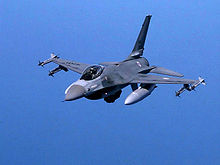
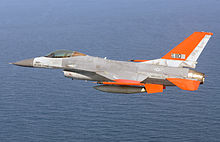

No comments:
Post a Comment